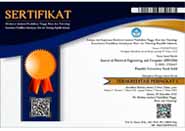Lighting System Control for Cataract Maturity Imaging Device
Authors (s)
(1) Katon Bagus Setiawan ()
Indonesia
(2) * I Komang Somawirata
 ()
() Indonesia
(3) Irmalia Suryani Faradisa ()
(*) Corresponding Author
AbstractAs technology advances, various innovations have been made to assist in diagnosing and treating cataracts. In cataract detection, artificial intelligence-based methods such as Convolutional Neural Networks (CNN) have proven very effective in detecting cataracts. CNN can classify eyes with an accuracy of up to 87%. In addition to image processing techniques such as CNN, the quality of the resulting images highly depends on the lighting system used during the eye image capture. This research expects the lighting system to be designed to adjust light intensity flexibly. This feature allows for adjusting brightness as needed, ensuring high-quality image results without compromising eye health. From this research, the image quality test results show good quality in the duty cycle range of 23.53% to 62.75% with light intensity of 30-84 lux. This indicates that the light intensity at the medium level produces images with good indicators. However, the light intensity conditions at the medium level begin to vary in terms of visual comfort and are still tolerable by most users. In the final test, an experiment involving respondents and image analysis using image processing was conducted. From the experiment, the respondents felt comfortable with the light intensity emitted by the LED. In the image processing section, the average number of images taken to obtain a good indicator was 3 times. A structured lighting system can ensure that good image results are obtained and patients feel comfortable with the light intensity used.
|
Keywords
Cataract Eye; LED Lighting; PWM; OpenCV; Image Processing
Full Text: PDF
Refbacks
- There are currently no refbacks.
Copyright (c) 2025 Katon Bagus Setiawan, I Komang Somawirata, Irmalia Suryani Faradisa

This work is licensed under a Creative Commons Attribution License (CC BY-SA 4.0)
Journal of Electrical Engineering and Computer (JEECOM)
Published by LP3M Nurul Jadid University, Indonesia, Probolinggo, East Java, Indonesia.








